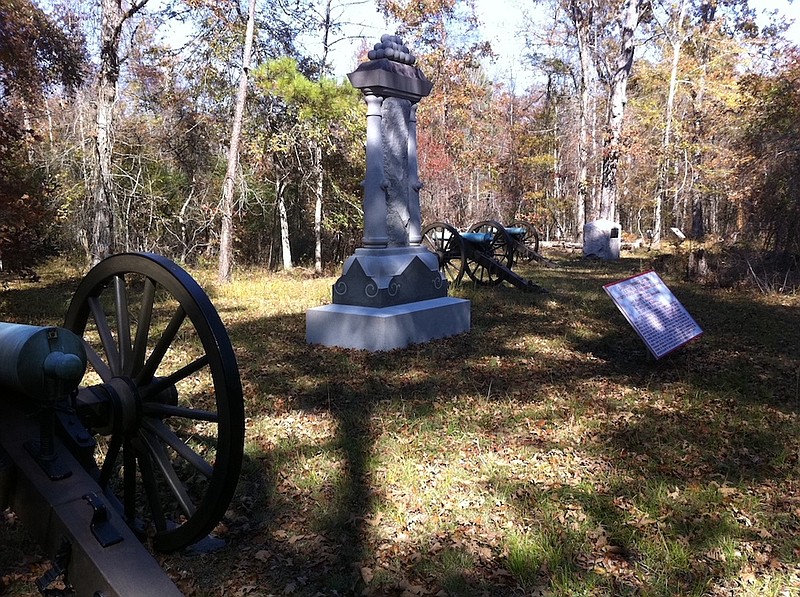For the Civil War enthusiast, among the charms of the Chickamauga Battlefield are the monuments and markers deep in the woods that are like hidden gems of history, telling stories of the heroic struggle of long-dead participants. In the summer, finding these gems means navigating around the non-native, invasive Chinese privet and mud holes from frequent rains, facing armies of voracious ticks, and avoiding poison oak and ivy.
One of those hidden gems is just to the south of Brotherton Road, on a short trail extending from the lengthy north-south trail paralleling Lafayette Road. There, monuments to Confederates from Tennessee are clustered, units from Wright's Brigade of Cheatham's Division, who fought a losing battle in the woods on the bloody afternoon of Sept. 19, 1863. Among those monuments are a larger monument to Capt. W.W. Carnes' Tennessee battery, and two 12-pounder and two six-pounder commemorative cannon.
The battery was organized in May 1861, when Tennessee entered into a military alliance with the Confederacy. It came under the command of Carnes, an 1857 graduate of the U.S. Naval Academy, before the Battle of Shiloh in April 1862. The battery helped cover the retreat from that battlefield and fought fiercely at Perryville and Murfreesboro. On the night of Sept. 18, 1863, it encamped on the east side of Chickamauga Creek, about three miles south of Lee and Gordon's Mill.
Early the next morning, the men heard firing to their north. Cheatham's Division marched in that direction and was thrown into a fight that had begun earlier that morning in the northeast quadrant of the current battlefield park. Wright's Brigade was on the division's left, and Carnes' Battery was deployed on the extreme left of Wright's Brigade, as Gen. Wright was concerned about that flank. The guns were unlimbered "under a bitter fire of musketry and artillery," and the enemy was so close that only shotgun-like canister rounds were used. While the battery faced generally northwest, the Ohio, Kentucky and Indiana troops of Brig. Gen. Samuel Beatty's brigade burst out of the woods on Carnes' left (southern) flank. The troops of the 79th Indiana were ordered to open fire and "disable the men and the horses."
The effect of the federal fire on the Rebel position was terrible. Wright's Brigade was driven off, and men and horses began falling around Capt. Carnes. He reoriented one of the guns to face Beatty's threat, but instead of firing to drive the federals off, it soon became clear that the only course of action was to cover a retreat. Carnes gave orders to try to at least remove his one piece, but the six horses of the gun's team were shot down. Carnes, seeing that saving his guns was not possible, directed the men to leave. As capturing cannon was a mark of distinction for Civil War units, the federal troops seemed more focused on shooting down the horses to prevent the pieces from being moved, thus making it possible for Carnes and a few of his men to escape, with Carnes barely getting away on a horse that itself suffered five wounds.
The park service marker on the site indicates that out of an aggregate of 76 men in the battery, one officer was killed, 37 men were killed or wounded, and reflecting the federal focus on immobilizing the battery, 49 horses were killed.
Fortunately for the Confederates, the captured guns were soon recovered, as Maj. Gen. A.P. Stewart's division arrived on the field and launched a fierce attack into the space formerly occupied by Wright's Brigade. Carnes and his men were assigned to another of Cheatham's batteries that had suffered similar casualties, and eventually the battery was restored with all new equipment and four modern, 12-pound Napoleon pieces.
At the end of 1863, Annapolis graduate Carnes transferred to the Confederate navy. His reconstituted battery served the rest of the war, surrendering with the remnants of the Army of Tennessee in North Carolina in April 1865. The larger monument to the battery was erected in 1900, and Carnes himself lived to just a few months short of his 91st birthday in 1932. The only commemoration the 49 dead horses received is the notation that they were killed on the battlefield park's red-lettered marker.
Local attorney and historian Sam D. Elliott is a former president of the Friends of the Chickamauga and Chattanooga National Military Park (now National Park Partners). For more information, visit Chattahistoricalassoc.org.
